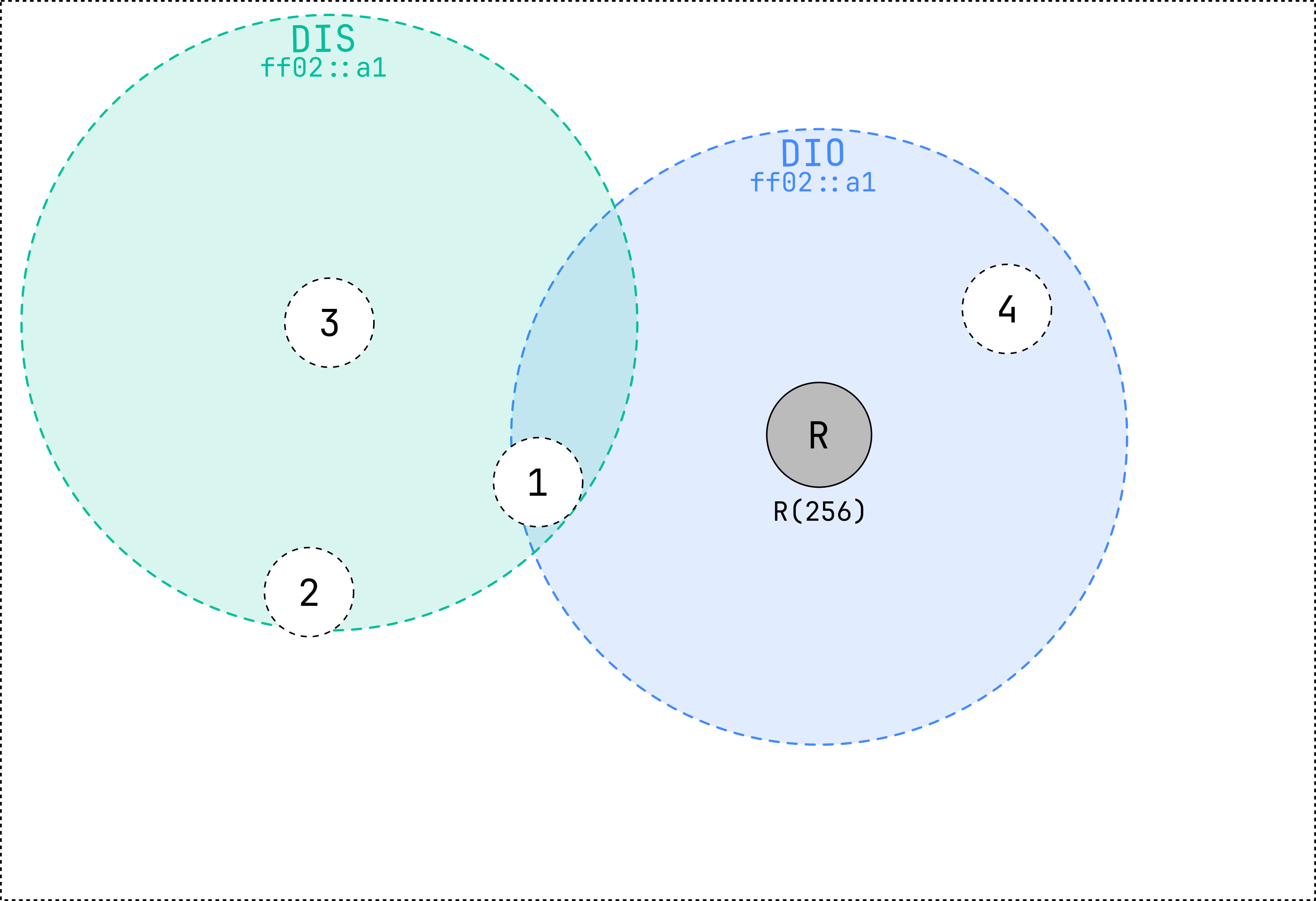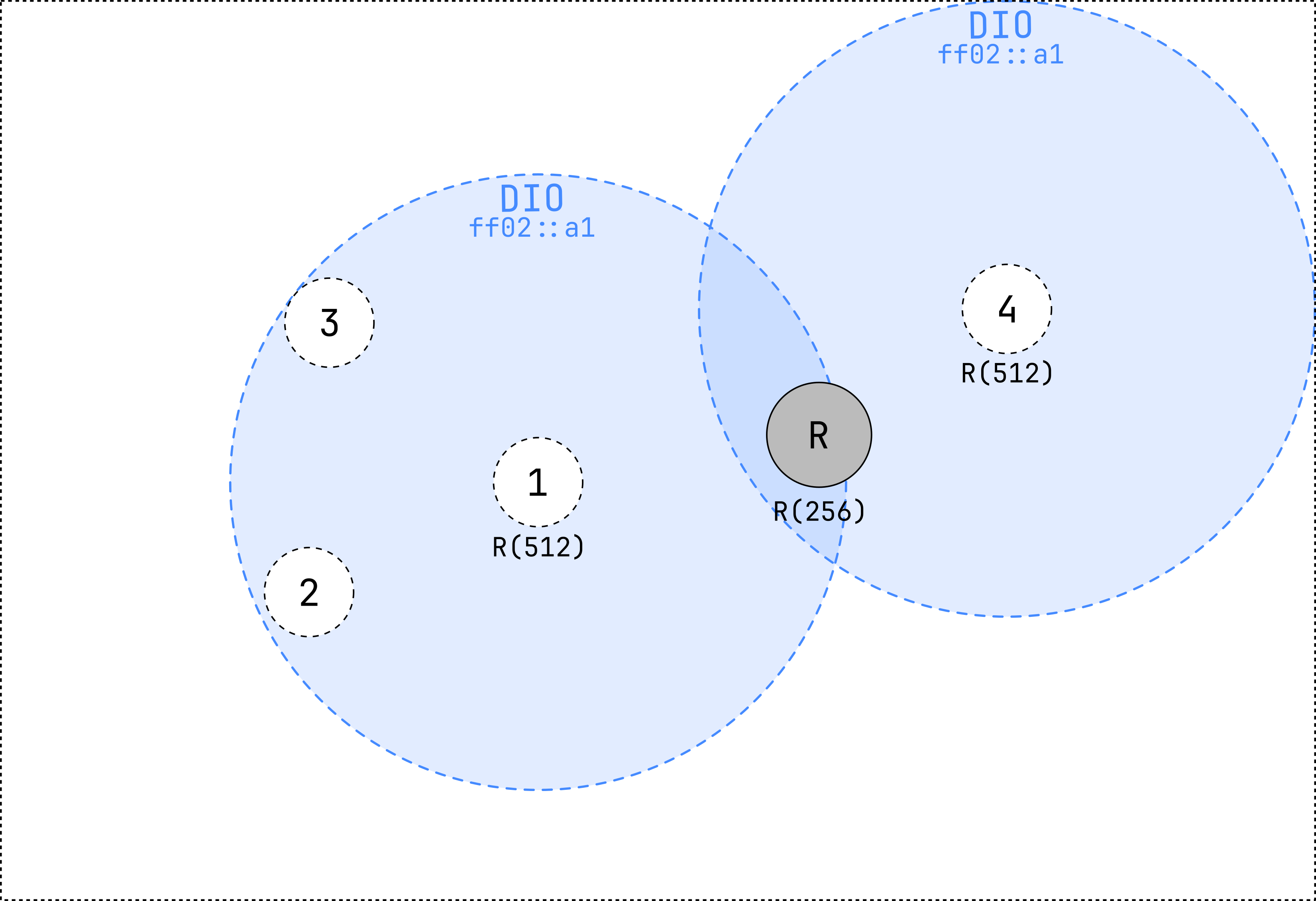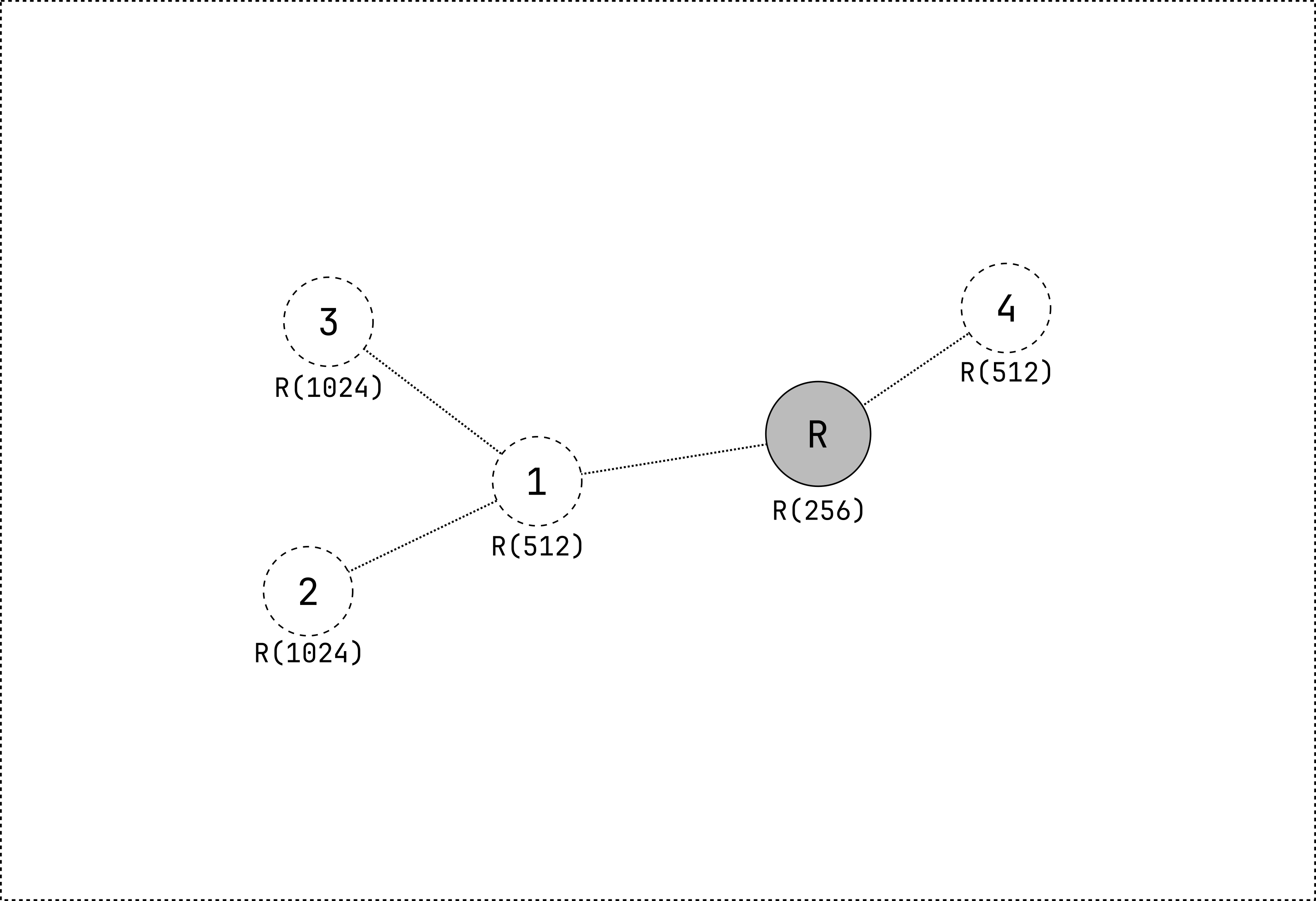MOP0: no downward routes maintained
In this mode of operation, the network is configured such that only upward routes are established. This means that any node in the network can transmit messages to the root node or any other node on its path towards the root, but not to other nodes in the network. The default route, represented by the parent of the node, is used to transmit data packets in an upward direction.
RPL network formation
The following network contains 5 nodes. The root node (R) and 4 normal nodes. They are all using the same RPL Instance ID, Mode of Operation and Objective Function.
 Figure 1: an empty network with 4 normal nodes and 1 root node.
Figure 1: an empty network with 4 normal nodes and 1 root node.
The root node periodically sends a DODAG Information Object (DIO) packet,
which contains information about the RPL network, more specifically about the DODAG.
The DIO message is sent using the all-RPL-node IPv6 multicast address (ff02::a1).
Nodes that receive this message will join the RPL network and select the root node as their parent.
These nodes will also set their rank based on the objective function and the information received in the DIO message.
They will also start sending DIO messages.
A node that does not hear any DIO message but wants to join a RPL network can send a DODAG Information Solicitation (DIS) message.
This message is sent to the all-RPL-node IPv6 multicast address (ff02::a1).
A node that is part of a RPL network will respond to this message with a DIO message.
 Figure 2: the root transmits a DIO and node 1 and 4 receive it.
Node 3 transmits a DIS message.
Figure 2: the root transmits a DIO and node 1 and 4 receive it.
Node 3 transmits a DIS message.
Nodes 1 and 4 have selected the root node as their parent and have calculated their rank. They now start to transmit DIO messages as well, based on the Trickle Timer algorithm. Since node 2 and 3 are in range of node 1, they will receive the DIO message and join the RPL network.
The root node also hears the DIO message from node 1 and 4, however, since their rank is higher than the root node's rank, the root node will ignore the DIO message. This guarantees optimal route selection and avoids loops.
 Figure 3: node 2 and 3 receive the DIO message from node 1 and 4 and join the RPL network.
Node 2 and 3 start sending DIO messages as well.
Figure 3: node 2 and 3 receive the DIO message from node 1 and 4 and join the RPL network.
Node 2 and 3 start sending DIO messages as well.
Every node in the network now has a parent and a rank. They will continue to send DIO messages based on the Trickle Timer algorithm. Other packets, such as data packets, are sent using the default route, which is the parent of the node. This means that data packets will always be sent in an upward direction, towards the root node. Node 1 will never be able to send a data packet to node 4, since node 4 is not on the path towards the root node. Neither will 3 be able to send a data packet to 2. However, node 2 can send a data packet to node 1, since node 1 is on the path towards the root node. This is not the use case for this mode of operation, but it is possible. The use case for this mode of operation is to send data packets to the root node, which collects the data and sends it to a server.
 Figure 4: the network is formed.
Figure 4: the network is formed.
Maintenance of a RPL network
The DIO messages will be sent by nodes even after the DODAG is formed. The goal of sending DIO messages for the whole life of a RPL network is to maintain or upgrade the formed DODAG. However, the constant generation of control messages can consume a lot of energy. To preserve resources, the sending of control messages is minimized and only done when necessary, through the use of the Trickle Timer algorithm.
The Trickle Timer algorithm monitors the consistency of packet exchange in the network. If the pattern is consistent and free of redundant or outdated data, the Trickle Timer decreases the rate of sending DIO messages exponentially. However, if there are any inconsistencies in the network, the next DIO message is rescheduled and sent at the shortest possible time interval. In other words, this algorithm ensures that DIOs are aggressively advertised when the network is unstable and advertised at a slower pace when it is stable.
There are four parameters that control the functioning of the Trickle Timer:
-
\(I_{min}\), which represents the minimum time interval between two DIO messages
-
\(I_{max}\), which represents the maximum time interval between two DIO message
-
\(k\), which represents the redundancy constant (the number of redundant control messages)
-
\(I\), which represents the size of the current time-interval
In the beginning, \(I\) is set to a random value between \(I_{min}\) and \(2 \cdot I_{min}\). DIO messages are sent when \(I\) expires and if the counter (\(c\)) that keeps track of the consistent received messages is smaller than \(k\). If the network is stable, \(I\) is doubled until it reaches \(I_{max}\). However, if inconsistencies are detected in the network, \(I\) is reset to a value between \(I_{min}\) and \(2 \cdot I_{min}\). This ensures efficient use of resources while still being able to ensure the maintainance of the network.
Usage with smoltcp
The RPL network can be formed using the smoltcp library.
The following feature flags need to be enabled: rpl-mop-0 and proto-sixlowpan.
Additionally, the proto-sixlowpan-fragmentation feature can be enabled to allow for fragmentation of 6LoWPAN packets.
The following configuration should be added to the configuration struct for the interface:
#![allow(unused)] fn main() { config.rpl = RplConfig::new(RplModeOfOperation::NoDownwardRoutesMaintained); }
When using RPL as a root node, the following configuration should be added:
#![allow(unused)] fn main() { config.rpl = RplConfig::new(RplModeOfOperation::NoDownwardRoutesMaintained) .add_root_config(RplRootConfig::new( RplInstanceId::from(30), // Change this to the desired RPL Instance ID Ipv6Address::default(), // Change this to the desired DODAG ID )); }
The interface should now behave like a RPL node in MOP0.
Summary
- Network is formed by sending DIO messages
- DIO messages are sent periodically using the Trickle Timer algorithm
- DIO messages are sent to the all-RPL-node IPv6 multicast address (
ff02::a1) - Nodes that receive a DIO message will join the RPL network
- Nodes that do not receive a DIO message can send a DIS message
- Packets only travel in an upward direction